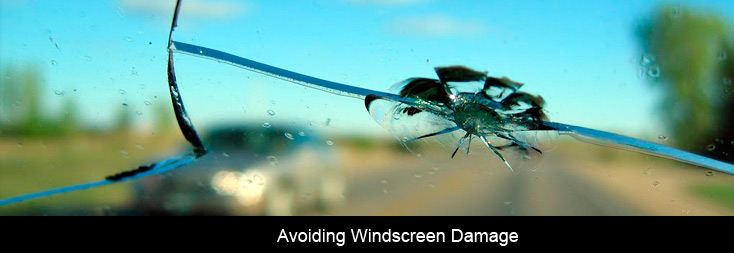How can my driving help to avoid windscreen damage?
The Arrive Alive website and Car Insurance Blog often receive queries from vehicle owners about damage to their windscreen caused by road construction whilst driving in construction zones. Most of us have experienced the dreaded noise of an object striking our windscreen from a passing vehicle. This is often regarded as those annoying insurance claims as we can too little to avoid the damage…or can we?
We decided to raise this with well known windscreen manufacturer PG Glass to benefit from their experience and info received from millions of chipped and repaired windscreens! We would like to share some of the advice given to the Arrive Alive website:
Windscreen Damage on South African roads
Based on the experience of PG Glass service centres more than 90% of windscreen claims result from stone damage.
It is accepted that debris on the roads like stones, rocks and grit will always have a direct influence on the number of windscreen claims. The more debris found on the roads, the more windscreen replacements you can expect.
Consequently, the concentration in the construction of new roads and road repairs that preceded and followed the 2010 Soccer World Cup in South Africa did contribute to a higher incidence of damaged windscreens.
Newly built roads, old roads breaking up, resurfacing of old roads, pot holes, trucks driving on the road shoulder, flood damage, and spillage from trucks carting building materials or rubble are all causing more debris on the roads.
Avoiding windscreen damage on South African roads
The faster you go, the easier your windscreen will chip or crack when it is hit by a stone. That’s why city driving contributes to far less claims than is experienced from driving on the freeways and other national and provincial roads.
Likewise, the closer you follow another vehicle, the higher is the chance that a piece of debris will hit your windscreen.
The best way to avoid your windscreen from being damaged by flying stones or other debris is to keep a safe following distance in circumstances where such damage may occur, e. g. in areas of road construction, on gravel roads or when following a truck carrying building materials or rubble. Sixty meters is considered a safe distance.
It will also be a good idea to drive slower in such circumstances.
It is not only trucks carrying endangering loads that can cause damage to a windscreen. In a high number of cases windscreen chips or cracks result from stones thrown by the wheels of passenger cars.
All load carrying vehicles are compelled by road traffic regulation 246 to properly protect any goods it is carrying from being dislodged or spilled from such a vehicle. If not, the operator or the driver must take responsibility for resulting damage. In such a case you can identify the operator through the license plate, obtaining the name and address of the registered owner from your local licensing authority and take action against them.
However, you’ll have to prove that the object that caused the damage was spilled from the vehicle you identified.
If your vehicle is insured your insurance company would most likely cover the cost of replacement. PG Glass will even submit the claim on your behalf.
Also view:
- Road Safety and Your Windscreen
- Road Safety near Construction Zones and Road Works
- The importance of clear vision
- LLumar Window Film and Road Safety
- Shatterprufe and Road Safety




